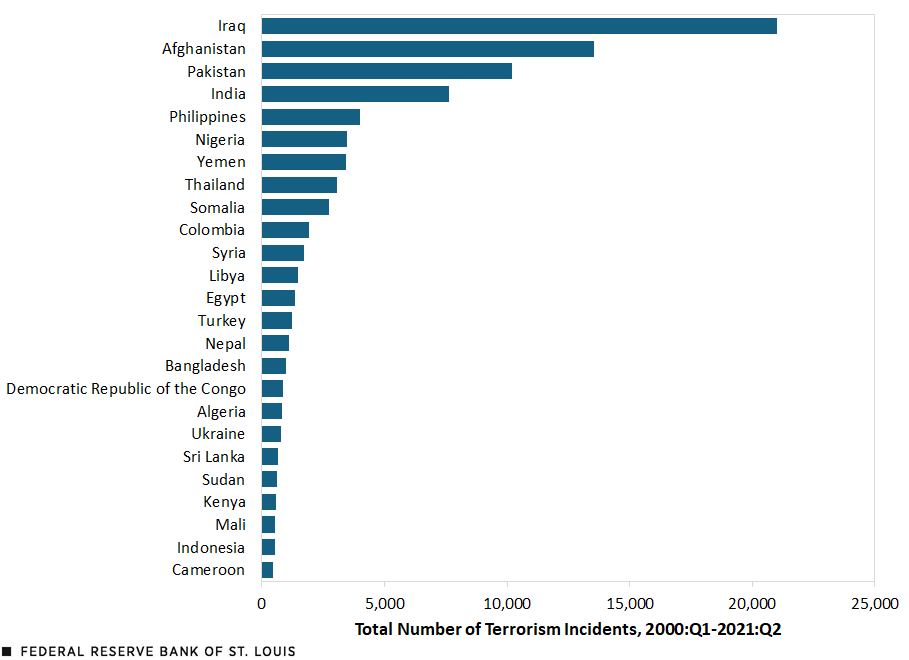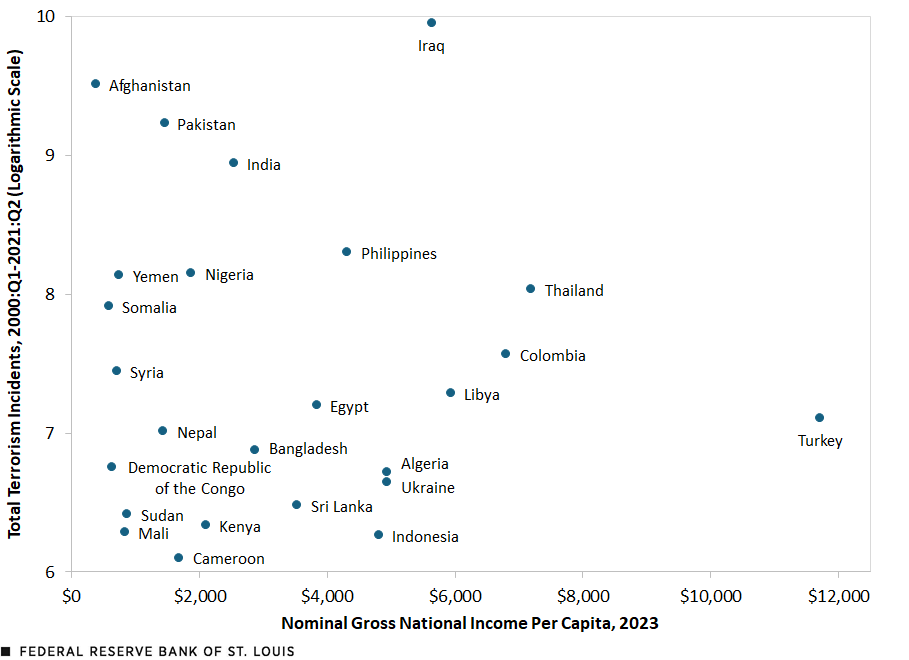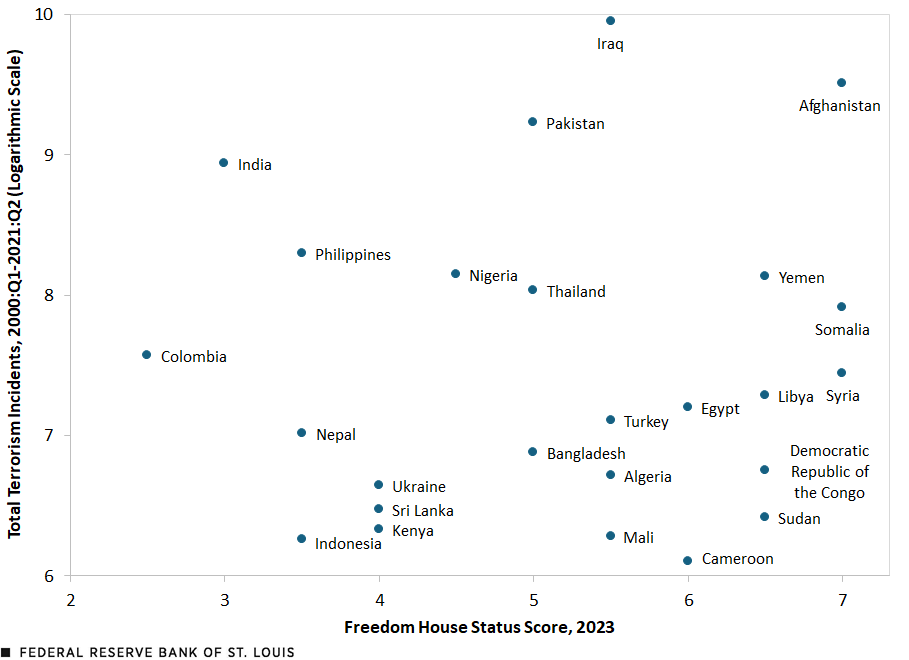Top 25 Developing Nations with Terrorism Incidents
About 93% of terrorism incidents reported between 2000 and the second quarter of 2021 in the Global Terrorism Database (GTD) occurred in developing nations.The GTD is maintained by the National Consortium for the Study of Terrorism and Responses to Terrorism (START). It is an open-source database that includes information on worldwide terrorist events beginning in 1970. The last data point in the GTD database is from the second quarter of 2021. An act must meet several GTD criteria for it to be classified as a terrorism incident exclusively (PDF). We use the term developing nations to represent those categorized by the World Bank in terms of their 2023 gross national incomes per capita as being low-income economies ($1,145 or less), lower middle-income economies ($1,146 to $4,515) and upper middle-income economies ($4,516 to $14,005). Why did developing nations feature so prominently? Possible reasons include fewer economic opportunities in poorer nations, which may lower the opportunity cost of engaging in terrorism, and fewer political and civil freedoms, which may stoke grievances.A word of caution here. There are reasons why terrorism may not flourish in some very poor nations or in nations with autocratic regimes, the latter of which may closely monitor their residents. For details, see Khusrav Gaibulloev and Todd Sandler’s June 2019 article, “What We Have Learned about Terrorism since 9/11,” in the Journal of Economic Literature.
This blog post focuses on these two possible reasons by exploring how the 25 developing nations with the largest number of terrorism incidents from 2000 to the second quarter of 2021 fared in terms of per capita incomes and political rights and civil liberties.We use 2023 nominal gross national income per capita. The status of political rights and civil liberties is measured by Freedom House’s combined average score of political rights and civil liberties for 2023. We do not differentiate by nations’ size or within-country heterogeneity. For example, a geographically large country may have a large number of terrorism incidents confined to a small area. Although this country may rank highly in terms of terrorism incidents, the terror risk for most of the country may be small.
Developing Nations with the Largest Number of Terrorism Incidents
The figure below lists the top 25 developing nations ranked by terrorism incidents. (We refer to these nations as selected nations from this point forward.The territories of Gaza and the West Bank are not included in this list.) Iraq experienced by far the largest number of incidents. Afghanistan, Pakistan and India ranked second to fourth on this list. The presence of Bangladesh, Nepal and Sri Lanka on the list shows that a large number of terrorism incidents took place in South Asia. Colombia is the only developing nation in the Americas on this list. Many African nations—both from northern and sub-Saharan Africa—also appear, with Nigeria and Somalia the top two from the continent.
Top 25 Developing Economies Ranked by Terrorism Incidents

SOURCES: Global Terrorism Database, World Bank and authors’ calculations.
NOTE: Developing economies are those classified by the World Bank as low income, lower middle income and upper middle income.
Terrorism Incidents and Gross National Incomes Per Capita
The next figure plots the number of terrorism incidents in the selected nations in logarithmic scale on the vertical axis and their respective 2023 gross national incomes per capita on the horizontal axis.
Among these nations, only Turkey had a per capita income above $7,500. Almost half had per capita incomes below $2,500. If we exclude Iraq, which is an outlier in terms of the number of attacks, low-income and lower middle-income economies—those with per capita incomes of less than $4,516—constituted about 71% of nations in the top 24 but accounted for about 85% of terrorism incidents.These are our calculations based on the GTD and World Bank data. Overall, lower-income developing nations in the group of selected nations had a disproportionate share of terrorism incidents.
Terrorism Incidents Were Concentrated in Lower-Income Selected Nations

SOURCES: Global Terrorism Database, World Bank and authors’ calculations.
NOTES: The range of terrorism incidents for the selected nations was 446 to 21,016. Cameroon had the smallest number of terrorism incidents with 446, which corresponds to a log value of 6.10. Iraq had the largest number of terrorism incidents with 21,016, which corresponds to a log value of 9.95. Gross national income data for Syria and Yemen are as of 2022 and 2018, respectively.
Terrorism Incidents and Political Rights, Civil Liberties
The figure below replicates the previous figure’s vertical axis while replacing per capita gross national income on the horizontal axis with the selected nations’ score on political rights and civil liberties as of 2023, where higher scores are placed closer to the origin.
Sixteen of the selected nations had scores in the range of 5 to 7, while only one (Colombia) was below 3.No nation in this group had a score in the range of 1 to 2. The figure suggests that among the selected nations, a small minority was characterized as having robust political rights and civil liberties.
A Minority of Selected Nations Scored Highly on Political Rights and Civil Liberties

SOURCES: Global Terrorism Database, Freedom House and authors’ calculations.
NOTES: The range of terrorism incidents for the selected nations was 446 to 21,016. Cameroon had the smallest number of terrorism incidents with 446, which corresponds to a log value of 6.10. Iraq had the largest number of terrorism incidents with 21,016, which corresponds to a log value of 9.95. Status score is a combined average of political rights and civil liberties, where 1 = Free and 7 = Not Free.
Conclusion
The observed patterns in the selected nations suggest both poverty and a lack of certain freedoms may correlate with terrorism. A more definitive answer about association and causation would require careful statistical analysis involving a larger sample of nations, which is beyond the scope of this blog post.
Notes
- The GTD is maintained by the National Consortium for the Study of Terrorism and Responses to Terrorism (START). It is an open-source database that includes information on worldwide terrorist events beginning in 1970. The last data point in the GTD database is from the second quarter of 2021. An act must meet several GTD criteria for it to be classified as a terrorism incident exclusively (PDF). We use the term developing nations to represent those categorized by the World Bank in terms of their 2023 gross national incomes per capita as being low-income economies ($1,145 or less), lower middle-income economies ($1,146 to $4,515) and upper middle-income economies ($4,516 to $14,005).
- A word of caution here. There are reasons why terrorism may not flourish in some very poor nations or in nations with autocratic regimes, the latter of which may closely monitor their residents. For details, see Khusrav Gaibulloev and Todd Sandler’s June 2019 article, “What We Have Learned about Terrorism since 9/11,” in the Journal of Economic Literature.
- We use 2023 nominal gross national income per capita. The status of political rights and civil liberties is measured by Freedom House’s combined average score of political rights and civil liberties for 2023. We do not differentiate by nations’ size or within-country heterogeneity. For example, a geographically large country may have a large number of terrorism incidents confined to a small area. Although this country may rank highly in terms of terrorism incidents, the terror risk for most of the country may be small.
- The territories of Gaza and the West Bank are not included in this list.
- These are our calculations based on the GTD and World Bank data.
- No nation in this group had a score in the range of 1 to 2.
Citation
Subhayu Bandyopadhyay and Hoang Le, ldquoTop 25 Developing Nations with Terrorism Incidents,rdquo St. Louis Fed On the Economy, May 1, 2025.
This blog offers commentary, analysis and data from our economists and experts. Views expressed are not necessarily those of the St. Louis Fed or Federal Reserve System.
Email Us
All other blog-related questions



